Nuremberg Laws
After Hitler rose to power in 1933, the Nazis began to implement antisemitic policies, which included the formation of a Volksgemeinschaft (people's community) based on race.Persons convicted of violating the marriage laws were imprisoned, and (subsequent to 8 March 1938) upon completing their sentences were re-arrested by the Gestapo and sent to Nazi concentration camps.As Jews were no longer permitted to work in the civil service or government-regulated professions such as medicine and education, many middle-class business owners and professionals were forced to take menial employment.[2] The party platform included removal of the Weimar Republic, rejection of the terms of the Treaty of Versailles, radical antisemitism, and anti-Bolshevism.[8] On 21 March 1933, former U.S. congressman William W. Cohen, at a meeting of the executive advisory committee of the Jewish War Veterans of the United States, urged a strict boycott against all German goods.[9] Later that month, a worldwide boycott of German goods was declared, with the support of several prominent Jewish organisations (though with the abstention of others, such as the Board of Deputies of British Jews).[20] This law was also used to force the incarceration in prison or Nazi concentration camps of "social misfits" such as the chronically unemployed, prostitutes, beggars, alcoholics, homeless vagrants, Black people, and Romani (referred to as Zigeuner "Gypsies").[24] This work was advanced by Robert Ritter of the Racial Hygiene and Population unit of the Ministry of Health, who by 1942, had produced a scale of ZM+, ZM of the first and second degree, and ZM- to reflect an individual's decreasing level of Romani ancestry.[24] Disenchanted with the unfulfilled promise of Nazi Party leaders to eliminate Jews from German society, SA members were eager to lash out against the Jewish minority as a way of expressing their frustrations.A Gestapo report from early 1935 stated that the rank and file of the Nazi Party would set in motion a solution to the "Jewish problem ... from below that the government would then have to follow".[32] Israeli historian Otto Dov Kulka argues that there was a disparity between the views of the Alte Kämpfer (longtime party members) and the general public, but that even those Germans who were not politically active favoured bringing in tougher new antisemitic laws in 1935.[35] Hjalmar Schacht, Economics Minister and Reichsbank president, criticised the violent behaviour of the Alte Kämpfer and SA because of its negative impact on the economy.[34] From Hitler's perspective, it was imperative to quickly bring in new antisemitic laws to appease the radical elements in the party who persisted in attempting to remove the Jews from German society by violent means.[40] In a speech on 12 September, leading Nazi physician Gerhard Wagner announced that the government would soon introduce a "law for the protection of German blood".[40] He then spoke with Hans Pfundtner, State Secretary in the Reich Interior Ministry, and Wilhelm Stuckart, a Ministerial Counselor, instructing them to draft a law forbidding sexual relations or marriages between Jews and non-Jews.They, in turn, summoned Franz Albrecht Medicus [de] and Bernhard Lösener of the Interior Ministry to Nuremberg to assist with the hurried drafting of the legislation.[44] Propaganda Minister Joseph Goebbels had the radio broadcast of the passing of the laws cut short, and ordered the German media to not mention them until a decision was made as to how they would be implemented.[62] As the law did not permit capital punishment for racial defilement, special courts were convened to allow the death penalty for some cases.[61] Concerned that international opinion would be adversely swayed by the new laws, the Interior Ministry did not actively enforce them until after the 1936 Summer Olympics, held in Berlin that August.This was part of the ongoing Aryanisation process (the transfer of Jewish firms to non-Jewish owners, usually at prices far below market value) that the regime had initiated in 1933, which intensified after the Nuremberg Laws were passed.[72] Former middle-class or wealthy business owners were forced to take employment in menial jobs to support their families, and many were unable to find work at all.[75] By the start of the Second World War in 1939, around 250,000 of Germany's 437,000 Jews had emigrated to the United States, the British Mandate of Palestine, Great Britain, and other countries.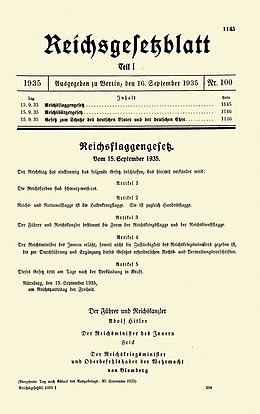
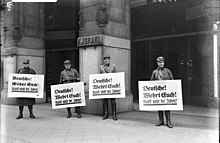

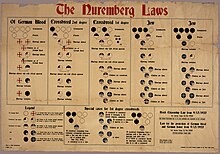
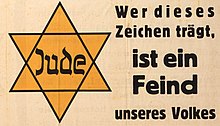
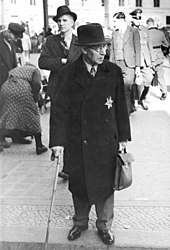
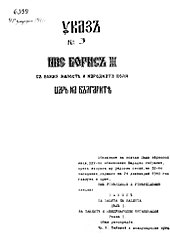

Nuremberg principlesNuremberg Codegovernment gazetteReichsgesetzblattDiscriminationInstitutionalStructuralStatisticalTaste-basedDialectDisabilityGeneticHair textureHeightLanguageMental disorderRace / EthnicitySkin colorScientific racismSexual orientationSpeciesViewpointArophobiaAcephobiaAdultismAnti-albinismAnti-autismAnti-homelessnessAnti-drug addictsAnti-intellectualismAnti-intersexAnti-left handednessAnti-MasonryAporophobiaAudismBiphobiaClannismElitismEphebiphobiaHealthmentalin povertyFatphobiaGayphobiaGerontophobiaHeterosexismHIV/AIDS stigmaHomophobiaIn-groupLeprosy stigmaLesbophobiaDiscrimination against menMisandryMisogynyNepotismOutgroupPedophobiaPerpetual foreignerPregnancySectarianismSupremacismAryanismAutisticChauvinismFemaleNordicismJewishUltranationalismTransphobia21st-century anti-trans movement in the United KingdomNon-binaryTransmisogynyTrans menVegaphobiaXenophobiaReligiousAtheismCampaigns in ChinaBaháʼí FaithBuddhismChristianityPersecutionCatholicismEastern OrthodoxyJehovah's WitnessesLDS or MormonProtestantismTewahedo Orthodoxypost–Cold War eraFalun GongHinduismUntouchabilityAhmadiyyaShi'ismSufismSunnismminority MuslimJudaismNeopaganismRastafariSikhismYazidismZoroastrianismnationalAfghanAfricanAlbanianArmenianFranceSouth AfricaUnited StatesAssyrianAustralianAustrianAzerbaijaniBlack peopleAfrican AmericansBengaliBulgarianCatalanChechenChineseColombianEnglishEstonianFilipino